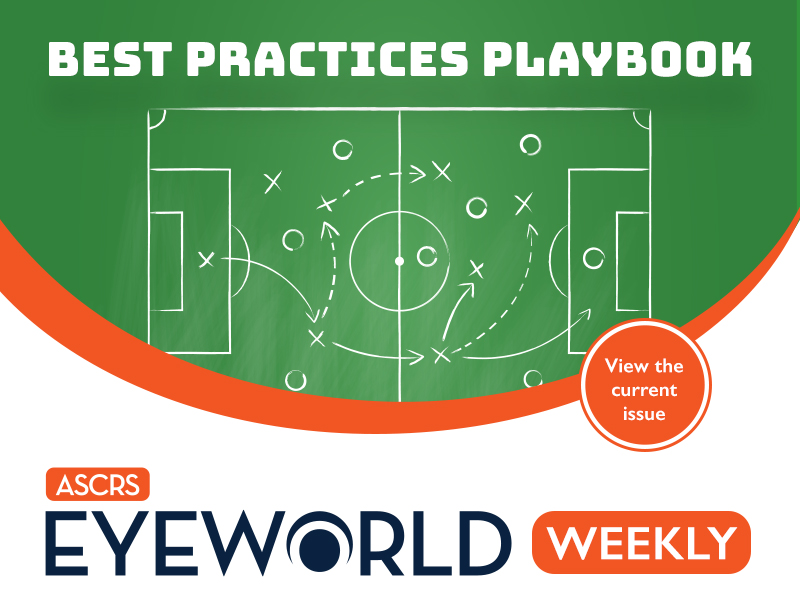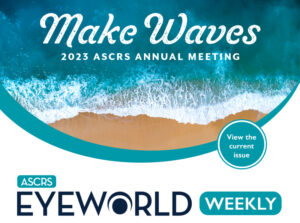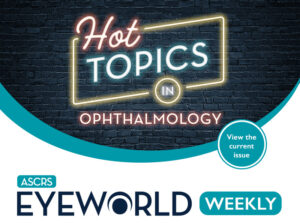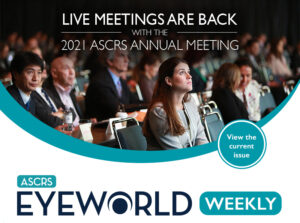
- FDA approves high-dose aflibercept
- Positive results in Phase 1 trial for cultivated autologous limbal epithelial cells
- Study: data from eye scans detect Parkinson’s disease years before clinical presentation
- Phase 2/3 study to evaluate persistent corneal epithelial defect treatment
- Phase 3 study offers results with aflibercept biosimilar
- ASCRS news and events
August 25, 2023 • Volume 29, Number 34
FDA approves high-dose aflibercept
The FDA has approved EYLEA HD (Regeneron), an 8 mg injection of aflibercept, for treatment of wet AMD, diabetic retinopathy, and diabetic macular edema. The approval, according to the company’s press release, is based on trials that showed clinically equivalent visual gains of EYLEA HD compared to EYLEA (aflibercept) injection 2 mg; these gains were maintained with fewer injections, according to the company. EYLEA HD is approved for 8-week and up to 16-week intervals (after 3 initial monthly doses) for patients with wet AMD and diabetic macular edema. It is approved for every 8–12 weeks for patients with diabetic retinopathy.
Positive results in Phase 1 trial for cultivated autologous limbal epithelial cells
Positive results from a Phase 1 trial evaluating cultivated autologous limbal epithelial cells (CALEC) in four patients who had significant corneal damage from severe chemical burns was reported by Mass Eye and Ear. The hospital’s press release showed that the CALEC treatment was safe and well tolerated. In the 12 months of follow-up, all patients had a restored corneal surface, allowing two to undergo a corneal transplant, and two didn’t require any additional treatment due to significant visual improvements. The press release reported that this is the first time the U.S. limbal stem cell grafts were developed to meet the FDA’s requirements for tissue engineering. The next phase includes 15 CALEC patients who will be tracked for 18 months.
Study: data from eye scans detect Parkinson’s disease years before clinical presentation
Research from the University College London and Moorfields Eye Hospital, in collaboration with other institutions, identified markers of Parkinson’s in retinal scans that were present up to 7 years before clinical presentation of the disease. According to a press release, the study used the AlzEye dataset, the UK Biobank dataset, and artificial intelligence. The researchers found that patients with Parkinson’s disease have reduced inner nuclear layer and ganglion cell-inner plexiform layer thicknesses. The authors wrote in the paper published in Neurology that the “involvement of these layers several years before clinical presentation highlight a potential role for retinal imaging for at-risk stratification of [Parkinson’s disease].”
Phase 2/3 study to evaluate persistent corneal epithelial defect treatment
Amber Ophthalmics announced that it has begun enrolling patients for its Phase 2/3 study that will evaluate Nexagon (lufepirsen ophthalmic gel) for treatment of persistent corneal epithelial defects (PCED). According to the company’s press release, the study will assess safety and efficacy of up to five in-office Nexagon treatments for patients with non-infections PCED. If patients do not re-epithelialize within 4 weeks of treatment, they will continue with weekly administrations until re-epithelization occurs or they reach 8 weeks of therapy. The primary endpoint of the study is complete corneal healing.
Phase 3 study offers results with aflibercept biosimilar
Sandoz, a Novartis division, announced positive results from its Phase 3 confirmatory efficacy and safety study that evaluated its aflibercept biosimilar as a treatment for patients with wet AMD. According to the company’s press release, the study compared BCVA from baseline to week 8 between the aflibercept biosimilar and reference biologic, EYLEA (Regeneron). The company reported no clinically meaningful difference in safety, immunogenicity, or pharmacokinetics. Sandoz stated that it will file for regulatory approval of its biosimilar aflibercept in the U.S. and E.U. in the coming months.
ASCRS news and events
- ASCRS Annual Meeting: The call for submissions for the 2024 ASCRS Annual Meeting is going on now through October 9. Find submission details here.
- ASCRS Satellite CME: Three clinical programs, a supplement to the main programming at the ASCRS Annual Meeting, are now available on demand. Find ASCRS Satellite CME offerings here.
- ASCRS Preoperative OSD Algorithm: The ASCRS Cornea Clinical Committee has launched a new program, building upon the experience of the ASCRS Preoperative OSD Algorithm. Join committee members as they provide a guided educational tour of the ASCRS Preoperative OSD Algorithm. The first of five tours is available now.
Research highlights
- A retrospective case series published in the Journal of Cataract & Refractive Surgery evaluated the outcomes of peripheral corneal relaxing incisions (PCRIs) to correct residual astigmatism after cataract surgery. The paper included 111 consecutive cases that had cataract surgery followed by PCRIs by one surgeon. The authors reported that after the PCRIs, mean UCVA was significantly improved; the percentage of eyes that saw 20/20 or greater increased by 36%. Mean refractive astigmatism magnitude decreased significantly with PCRIs, and more eyes had ≤0.25 D and ≤0.50 D of cylinder, among other significant effects, that confirmed the positive effect of PCRIs to correct low amounts of residual astigmatism, according to the authors.
- A multicenter, retrospective, comparative, non-randomized interventional study published in the American Journal of Ophthalmology sought to compare the safety and efficacy of different goniotomy treatment sizes. The study assessed 120°, 240°, and 360° goniotomies that occurred with and without cataract surgery in patients who had primary open angle glaucoma. According to the paper, the procedure was successful if the postop IOP fell between 6–18 mm Hg and was at least 20% lower than baseline without additional glaucoma surgery. The research included 308 eyes of 231 patients who were followed for 14.4±8.6 months. According to the authors, there were no significant differences in IOP reduction, number of glaucoma medications, or those who also did not need IOP-lowering drops postop among the three goniotomy treatment sizes with or without cataract surgery. The authors reported that eyes that had a full 360° goniotomy with or without cataract surgery were more likely to experience hyphema.
This issue of EyeWorld Weekly was edited by Stacy Jablonski, Liz Hillman, and Ellen Stodola.
EyeWorld Weekly (ISSN 1089-0319), a digital publication of the American Society of Cataract and Refractive Surgery (ASCRS), is published every Friday, distributed by email, and posted live on Friday.
Medical Editors: Sumit “Sam” Garg, MD, Chief Medical Editor, Mitchell Weikert, MD, Cataract Editor, Karolinne Rocha, MD, PhD, Refractive Editor, Julie Schallhorn, MD, Cornea Editor, Manjool Shah, MD, Glaucoma Editor
For sponsorship opportunities or membership information, contact: ASCRS • 12587 Fair Lakes Circle • Suite 348 • Fairfax, VA 22033 • Phone: 703-591-2220 • Fax: 703-591-0614 • Email: ascrs@ascrs.org
Mention of products or services in EyeWorld Weekly does not constitute an endorsement by ASCRS.
Click here to view our Legal Notice.
Copyright 2023, EyeWorld News Service. All rights reserved.



